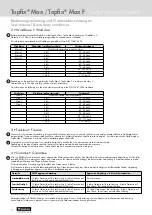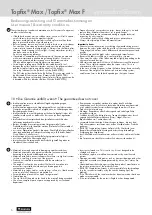
Topfix
®
Max / Topfix
®
Max F
Sunprotection-Screens
6
10 • Die Garantie verfällt, wenn • The guarantee does not cover
• die Materialien intensiv schädlichen Umgebungsbedingungen
ausgesetzt werden;
• die Materialien aggressiven Umgebungseinflüssen von Industrie oder
Gewerbe ausgesetzt sind und es infolgedessen zu Verfärbungen oder
Beschädigungen kommt;
• die Materialien in einer Umgebung mit hohem Salzgehalt in der Luft
installiert werden und es dadurch zu Korrosion an den Sägekanten
kommt;
• die Produkte nicht entsprechend den Installationsvorschriften des
Lieferanten angebracht werden;
• Bei der Montage die vorausgesetzten Neigungswinkel (siehe
Produktbröschure) nicht beachtet werden (Garantie für Wasserablauf
und die Folgen verfällt).
• es sich um Materialien handelt, die einem Verschleiß infolge vielfachen
oder lang anhaltenden Gebrauchs unterliegen (z. B. Bänder, Kabel,
Gurte, Federn, Aufroller usw.);
• die Montage mit zu schwachem Befestigungsmaterial erfolgt ist;
• es sich um natürliche Alterung handelt;
• die technischen Einsatzgrenzen des Produkts (gemäß Angaben im
Handbuch) überschritten sind;
• Komponenten verwendet werden, die weder den Vorschriften
entsprechen, noch durch unsere technische Abteilung anerkannt sind;
• es zu verkehrter oder forcierter Benutzung gekommen ist. Dieses
Produkt ist kein Spielzeug;
• Montage, Reparaturen oder Änderungen durch unbefugte Dritte
ausgeführt wurden;
• Schäden durch Dritte, beispielsweise Transportschäden, oder durch
ungewöhnliche Wetterverhältnisse (Sturm-, Hagel-, Wasser-,
Brandschäden usw.) entstanden sind;
• unvermeidliche ästhetische Abweichungen vorliegen, die aus dem
Pro duktionsprozess resultieren oder zu den Merkmalen des Produkts
gehören;
• RENSON Sunprotection-Screens haftet nicht für Glasbruch (zum
Beispiel durch fehlerhafte Montage oder durch ungleichmäßige
Erwärmung der Verglasung).
• der CE-Aufkleber mit Seriennummer entfernt ist oder nicht mehr lesbar
ist.
• die Seriennummer des Motors unleserlich oder verschwunden ist.
DE
• Materials intensively exposed to damaging weather conditions.
• Materials exposed to an aggressive industrial environment and
becoming discoloured or damaged as a result.
• Materials installed in an environment where there is a high salt content
in the air, resulting in corrosion of the grooves.
• Products not installed in accordance with the manufacturer’s
instructions.
• The angle of inclination (see product file) hasn’t been taken into
account during installation (warranty on drainage and its
consequences expires).
• Materials (e.g. tapes, cables, cords, springs, rollers, etc.) that become
worn as a result of frequent or protracted use.
• Assembly taken place with too weak fixing material.
• Natural ageing.
• The use limits of the product (as listed in the manual) being exceeded.
• Use of non-compliant parts or parts not approved by our technical
department.
• Incorrect or forced use. This is not a toy. It is not designed to be
climbed or hang on.
• Installation, repairs or modifications carried out by unauthorised
persons.
• Damage caused by third parties, such as transport damage, and other
abnormal circumstances (damage caused by storms, hail, water, fire,
etc.).
• Unavoidable aesthetic changes resulting from product manufacture or
the intrinsic properties of the product/screen.
• RENSON Sunprotection-Screens is not responsible for glass breakage
(e.g. by incorrect assembly or by the uneven heating up of the
glazing).
• If the CE-sticker with the serial number has been removed or has been
made unrecognizable.
• If the serial number for the motor is illegible or has disappeared.
EN
Bedienungsanleitung und Garantiebestimmungen
User manual & warranty conditions
The system does not need much maintenance, but for years of enjoyment,
we advise the following:
• If the fabric becomes wet in a sudden storm, you can still roll it up and
unroll it later to dry when the weather is better.
However, avoid having the wet fabric rolled up for more than three
days to prevent formation of mould and spots.
• Before cleaning, remove any loose dirt with a brush or vacuum cleaner.
You can then use a cleaning product (avoid caustic products) and
warm water to remove the remaining dirt. Always rinse the fabric after
cleaning. Avoid cleaning in full sunlight: if soapy water dries quickly, it
can leave spots on the fabric.
Do not use aggressive abrasives.
• If anodised or enamelled profiles become dirty, they can be cleaned
with warm water and a gentle-acting cleaning product. Never use
aggressive products, abrasive sponges or other abrasive media.
We also advise against using high-pressure equipment.
• Swivelling or rotating parts should be lubricated annually. Incl.
between the pulleys and their stainless steel axis, the alignment wheels
and their stainless steel axis and the wheels of the trolleys.
Use a dry lubricant for this (Veidec Dry Lube (G6002790)).
The PVC side guides that hold the Topfix Max (F) screen zips, need to
be lubricated at least once a year (Ceramic Lube (G6002795)).
• After cleaning (remove twigs and leaves), plastic sliding sleeves can be
lubricated with a dry lubricant (Veidec Dry Lube (G6002790)).
• Frequently control your product on twigs, leaves, bird nests, ets. and
remove them. Maintain the product “as a good keeper”.
• As the manufacturer, we recommend having a regular technical
inspection by your installer:
- Annually at public utility building and at your private home.
• Always use original parts from the manufacturer.
Important to know:
• Minor colour variations may occur during the manufacturing process
between the colour guides and the profiles of the sunprotection screen.
There may also be minor colour differences between components and
profiles.
• The fabric may exhibit slight colour nuances and imperfections.
• Because the fabric is rolled up, it can form folds or creases.
• Over time, the colour of the fabric may fade slightly, depending on the
chosen colour and design.
• Milk stains can appear with the use of the Rensonscreen Waterproof
screen. These stains disappear when the screen is dry. This is a
characteristic of this screen.
• In the case of straight screens, where the fabric hangs down vertically
because of the weight of the bottom rail or a tensioning system,
wrinkles can form in the fabric depending on the type of screen.
EN


























